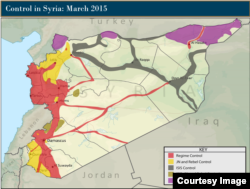The Syrian government has suffered several significant military setbacks in recent days and for the first time in more than four years, forces loyal to President Bashar al-Assad are decidedly weakened, analysts say.
It is too soon, however, for the opposition to celebrate.
Rebel groups in recent days took hold of the northwestern city of Jisr Al-Shughour, the last major city Assad forces had held in Idlib province after the opposition took its capital, Idlib city, last month.
This is a major loss for the government. Jisr Al-Shughour is located along the road connecting Aleppo with the Alawite heartland, Latakia, making regime-held coastal areas more vulnerable to attack.
Early this week, the opposition also overran Al-Qameed military base in near the town of Ariha in Idlib province, making off with tanks, armored vehicles and ammunition.
The Britain-based Syrian Observatory for Human Rights says the rebels have since captured dozens of regime forces, government-allied soldiers and their families in and around Jisr Al-Shughour.
What’s perhaps most significant about these attacks is that several major Islamist rebel groups – including the al-Qaida-affiliated Nusra Front, Chechen and Moroccan fighters, united in a joint effort they dubbed “Battle for Victory” to conduct the offensive.
In recent weeks, rebels have also made significant gains in the south, said Robert S. Ford, a Senior Fellow at the Middle East Institute and a U.S. Ambassador to Syria, who recently returned from a trip to Jordan to assess the crisis.
“I met with some of the fighting groups down there,” he said. “They have a much more reliable logistics chain now and they’ve actually made some strong advances on the ground, including seizing the regime stronghold of Busra Ash Sham, not far from Jordan, and the last remaining border crossing the Syrian government had with Jordan, at Nasib.”
In early April, ISIS stormed Yarmouk, a district in Syria’s capital that houses Syria’s largest Palestinian refugee population, situated just three miles from the presidential palace in Damascus. This now means that the Islamic State holds as much as a third of the country.
IS now controls a large percentage of populated areas in the northeast, from Aleppo to the Iraqi border and has seized a number of former Syrian military bases there. Last summer, IS took all of the remaining government-held bases in Raqqa province and it has also seized a base at Hasakah.
Meanwhile, the Nusra Front and allied rebel groups now hold large areas in Aleppo province, in the northeast, and in Daraa province, to the south,” said Jennifer Carafalla, a Syria researcher with the Institute for the Study of War (ISW).
“In addition, they hold the Syrian-Lebanese border region northeast of Damascus, which is this really rugged, mountainous terrain where ISIS also maintains a presence,” she said. “There, they can hunker down in caves and such and be relatively protected from Hezbollah and regime forces.”
This week, Islamic rebels battled ISIS forces near the border with Israeli-held Golan Heights
Family troubles?
Meanwhile, reports suggest Assad may be facing threats of a coup from inside the family. He recently detained his cousin, businessman Munzer al-Assad, in Latakia for reasons that aren’t completely clear. Some reports said Munzer had been communicating with Bashar’s uncle Rifaat, exiled in London -- an indication that they might be working against the government.
“But there are other signs of tension inside the regime, which I think are even more serious,” Ford said.
Last month, he explains, the government fired two of the four spy chiefs, General Rustom Ghazaleh, head of political intelligence, and General Rafiq Shehadeh, head of military intelligence.
Ghazaleh died last week under unclear circumstances. Lebanon’s former Prime Minister Saad Hariri said he had been beaten to death to prevent him from speaking out against the regime.
“It happens they assassinate themselves sometimes,” Hariri recently told an audience at the Wilson Center in Washington, D.C., a sarcastic reference to a number of Syrian intelligence officials who have died mysteriously in recent years.
“So the regime is really in a defensive situation,” said Ford. “They really are a minority regime in a war of attrition.”
But that doesn’t mean the government is ready to collapse.
“For now, Assad is still strong,” said Joshua Landis, director of the Center for Middle East Studies at the University of Oklahoma.
“Assad also has advantages over the opposition -- a central command, which other parties don’t have, and an air force,” he said.
The government still controls about two-thirds of the country – half of Aleppo and all of the country’s largest remaining cities—Homs, Hama, Latakia and, most importantly, Damascus.
Part of Assad’s strategy, says ISW’s Carafalla, is to maintain outposts in all of Syria’s corners.
“So he has a small contingent of fighters up in northeastern Syria in Hassakeh city and in Qamishli on the Syrian-Turkish border. He has a contingent in Deir-Ezzor city in the southeast," he said.
"And he maintains military positions spread out throughout all of Syria in an attempt to portray an image of staying power and to deter against proposals that you can Balkanize Syria,” Caraffala said.
“Remember, we always said, ever since the crisis began four years ago, as long as Damascus doesn’t fall, Assad is in power,” said Hamdi Rifai, a former New York Attorney who heads an organization called Arab Americans For Democracy in Syria.
Damascus hasn’t fallen, thanks in part to checkpoints every hundred feet, said Rifai, and a military presence on every corner.
And as long as Assad controls Damascus, Rifai said, the Syrian leader can still stay in power to some degree somewhere.









